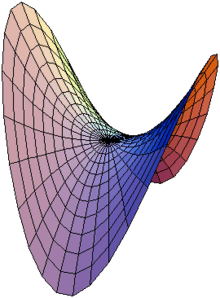Saddle surface


A saddle surface is a smooth surface containing one or more saddle points. The term derives from the peculiar shape of historical horse saddles, which curve both up and down.
Classical examples of two-dimensional saddle surfaces in the Euclidean space are second order surfaces, the hyperbolic paraboloid  (which is often referred to as the saddle surface or "the standard saddle surface") and the hyperboloid of one sheet. The Pringles potato chip or crisp is an everyday example of a hyperbolic paraboloid shape.
(which is often referred to as the saddle surface or "the standard saddle surface") and the hyperboloid of one sheet. The Pringles potato chip or crisp is an everyday example of a hyperbolic paraboloid shape.
Saddle surfaces have negative Gaussian curvature which distinguish them from convex/elliptical surfaces which have positive Gaussian curvature. A classical third-order saddle surface is the monkey saddle.
The Ph.D. thesis of Grigori Perelman, titled "Saddle surfaces in Euclidean spaces," was devoted to saddle surfaces.[1]
References
- ↑ Перельман, Григорий Яковлевич (1990). Седловые поверхности в евклидовых пространствах: Автореф. дис. на соиск. учен. степ. канд. физ.-мат. наук (in Russian). Ленинградский Государственный Университет.
Further reading
- Hilbert, David; Cohn-Vossen, Stephan (1952). Geometry and the Imagination (2nd ed.). Chelsea. ISBN 0-8284-1087-9.
.png)